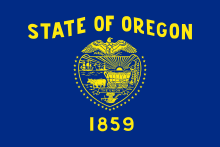
The U.S. state of Oregon has 27 official emblems, as designated by the Oregon State Legislature. Most of the symbols are listed in Title 19, Chapter 186 of the Oregon Revised Statutes (2011 edition). Oregon's first symbol was the motto Alis Volat Propriis, written and translated in 1854. Latin for "She Flies With Her Own Wings", the motto remained unchanged until 1957, when "The Union" became the official state motto. Alis Volat Propriis became the state motto once again in 1987. Originally designed in 1857, usage of the Oregon State Seal began after Oregon became the 33rd state of the United States on February 14, 1859. The motto and seal served as Oregon's only symbols until over 50 years later, when the Oregon-grape became the state flower in 1899. Oregon had six official symbols by 1950 and 22 symbols by 2000. The newest symbol of Oregon is brewer's yeast, declared the state microbe in 2013.
While some of the symbols are unique to Oregon, others are used by multiple states. For example, the North American beaver is also the state animal of New York, and the Chinook salmon (sometimes known as the king salmon) is also the state fish of Alaska. The square dance and milk are commonly used state dances and state beverages, respectively.
Insignia
Further information: List of U.S. state, district, and territorial insignia| Type | Symbol | Description | Adopted | Image | Note |
|---|---|---|---|---|---|
| Flag | Flag of Oregon | Oregon's flag is navy blue with gold lettering and imagery, and is the only current flag in the U.S. to have a different pattern on the reverse side. The obverse depicts the state seal with "STATE OF OREGON" displayed above and "1859" displayed below (the year Oregon was admitted to The Union). The reverse depicts a beaver in the center. | 1925 |  
|
|
| Motto | Alis Volat Propriis | Latin for "She Flies With Her Own Wings", Alis Volat Propriis was the motto of Oregon from 1854 until it was changed to "The Union" in 1957. Written by Judge Jesse Quinn Thornton, the original motto was adopted once again by the 1987 Legislature. | 1987 1854–1957 |

|
|
| Seal | Oregon State Seal | In 1857, a resolution adopted by the Oregon Constitutional Convention authorized the president to appoint a committee consisting of Benjamin F. Burch, La Fayette Grover and James K. Kelly to design a new seal to be used once statehood was achieved. Harvey Gordon designed the seal, though additions were added through committee recommendations. Usage began after Oregon became the 33rd state on February 14, 1859. | 1859 | 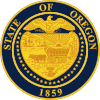
|
Flora and fauna
| Type | Symbol | Description | Adopted | Image | Note |
|---|---|---|---|---|---|
| Animal | American beaver (Castor canadensis) |
Found in most of the larger streams and rivers in Oregon, the beaver is the largest of the North American rodents. Once overtrapped by early settlers and prized for its fur, populations have recovered through management and partial protection. Oregon is known as "The Beaver State" and Oregon State University's athletic teams are called the Beavers. | 1969 | 
|
|
| Crustacean | Dungeness crab (Metacarcinus magister) |
Based on lobbying from school children at Sunset Primary School in West Linn, Oregon, and citing its importance to the Oregon economy, the Oregon State Legislature designated the Dungeness crab as the state crustacean in 2009. | 2009 | 
|
|
| Fish | Chinook salmon (Oncorhynchus tshawytscha) |
Salmon was essential for the coastal Native Americans' life, and was the subject of many legends and taboos. The largest of the Pacific salmon, the Chinook provides both sport and commercial fishing, but is under threat from dams and fishing. | 1961 | 
|
|
| Flower | Oregon-grape (Mahonia aquifolium) |
Native to the North American west coast, the Oregon-grape is an evergreen shrub that contains small purplish-black fruits that were included in smaller quantities in the traditional diets of Pacific Northwest aboriginal peoples. Today they are sometimes used to make jelly, alone or mixed with salal berries, another berry native to the Northwest. | 1899 | 
|
|
| Fruit | Pear (Pyrus) |
Pear orchards flourish in Oregon's river valley growing regions, producing about 800 million pears per year. Pears are Oregon's number one tree fruit crop. | 2005 | 
|
|
| Insect | Oregon swallowtail (Papilio oregonius) |
Containing the word Oregon in both its common and scientific names, this swallowtail species is native to the Northwest region, primarily found in the sagebrush canyons of the Columbia River and its tributaries. | 1979 | 
|
|
| Microbe | Brewer's yeast (Saccharomyces cerevisiae) |
S. cerevisiae has been instrumental to winemaking, baking and brewing since ancient times as the yeast behind the most common type of fermentation. It is a unicellular fungus about 5–10 micrometres in diameter. In addition to its role in food production, the yeast is used as a model organism for the study of aging, genomics, and other topics. | 2013 | 
|
|
| Mushroom | Pacific golden chanterelle (Cantharellus formosus) |
Most known for its "golden hue, chalice shape and delicate woodsy flavor", the Pacific golden chanterelle is a fungus found throughout Oregon's conifer forests. Tillamook State Forest annually produces one of the world's largest chanterelle harvests. | 1999 | 
|
|
| Nut | Hazelnut | Hazelnuts, also known as filberts, are produced in commercial quantities in Oregon, which has an ideal climate for growing the nuts. According to the state, Oregon's Willamette Valley is home to 99% of the U.S. hazelnut industry. | 1989 | 
|
|
| Raptor | Osprey (Pandion haliaetus) |
"Designated state raptor by the 2017 Legislature, declaring the large bird with its striking markings to be a fitting symbol of Oregon's rugged independence, strength and resilience, evoking Oregon’s lakes, rivers, streams and ocean". | 2017 | 
|
|
| Seashell | Oregon hairy triton (Fusitriton oregonensis) |
Named oregonensis by conchologist John Howard Redfield in 1846 to honor the Oregon Territory, the Oregon hairy triton is covered with bristly periostracum and found along the West Coast, washing up at high tide. | 1991 | 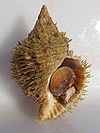
|
|
| Songbird | Western meadowlark (Sturnella neglecta) |
Unofficially chosen as the state bird in 1927 by Oregon's school children in a poll sponsored by the Oregon Audubon Society, the western meadowlark is native throughout western North America and is known for its "distinctive and beautiful song." However, the Governor's proclamation based on the poll was never ratified by the Oregon Legislature. In order to correct this oversight, the western meadowlark was voted State Songbird in 2017. | 2017 | 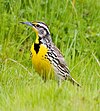
|
|
| Tree | Douglas-fir (Pseudotsuga menziesii) |
Named after David Douglas, a Scottish botanist who traveled through Oregon in the 1820s, the Douglas-fir is an evergreen conifer dominant throughout the region, occurring in nearly all forest types and able to compete well on most parent materials and slopes. Due to its "strength, stiffness and moderate weight", the species is an invaluable timber product. | 1939 | 
|
|
| Vegetable | Potato | Potatoes are the number one vegetable produced in Oregon, with over 2.7 billion pounds grown annually. | 2024 | 
|
Geology
| Type | Symbol | Description | Adopted | Image | Note |
|---|---|---|---|---|---|
| Fossil | Metasequoia | Dawn redwood flourished in the Miocene epoch and would become one of the most abundantly found fossils in Oregon today. While long extinct in the state, paleontologists discovered living 100-foot (30 m) Metasequoia trees in China more than 50 years ago and brought live trees back to the U.S. for propagation, thus ensuring their continued survival. | 2005 | 
|
|
| Gemstone | Oregon sunstone | Sunstones are plagioclase feldspars, which when viewed from certain directions exhibit a brilliant spangled appearance. The gemstone has increased tourism and economic development in southeastern Oregon, attracting collectors and miners to the region. | 1987 | 
|
|
| Rock | Thunderegg | Nodule-like geological structures similar to geodes, thundereggs are rough spheres found throughout Oregon, the largest deposits found in Crook, Jefferson, Malheur, Wasco and Wheeler counties. The world's largest thunderegg, a 1.75 ton specimen, is housed by the Rice Northwest Museum of Rocks and Minerals in Oregon. | 1965 | 
|
|
| Soil | Jory soil | A very deep, well-drained soil that forms in colluvium derived from basic igneous rock and found in the foothills surrounding the Willamette Valley. These soils have been mapped on more than 300,000 acres (1,200 km) in western Oregon and are named for the Jory family, who settled in the area in 1852 after traveling along the Oregon Trail. Jory soils are productive forest soils that support Oregon's stands of Douglas fir and Oregon white oak, as well as many Oregon crops, including Christmas trees, berries, filberts, grass seed, and the grapes used in the Oregon wine industry. | 2011 | 
|
Culture
| Type | Symbol | Description | Adopted | Image | Note |
|---|---|---|---|---|---|
| Beverage | Milk | Milk was recognized as the state's beverage because the production and manufacture of dairy products are major contributors to Oregon's economy. Tillamook County is particularly known for its dairy farms. Water had also been proposed as the state beverage in the same legislative session, but that proposal was tabled in favor of milk. | 1997 | 
|
|
| Dance | Square dance | A folk dance with four couples (eight dancers) arranged in a square, the "lively spirit of the dance exemplifies the friendly, free nature and enthusiasm that are a part of the Oregon Character." The "Oregon Waltz" had been proposed as the state waltz in 1997, but the proposal was rejected. | 1977 | 
|
|
| Father | Dr. John McLoughlin | McLoughlin was the chief factor of the Columbia Fur District of the Hudson's Bay Company at Fort Vancouver. In the late 1840s his general store in Oregon City was famous as the last stop on the Oregon Trail. He became designated as the "Father of Oregon" for his role in assisting the American cause in the Oregon Country. | 1957 | 
|
|
| Hostess | Miss Oregon | Founded in 1947 as the Miss Oregon Pageant by merchants in the coastal city of Seaside, the competition is a regional scholarship contest and beauty pageant that selects the representative for Oregon in the Miss America pageant. The annual event includes contestants from across the state and awards scholarships to the participants. | 1969 | 
|
|
| Mother | Tabitha Moffatt Brown | Brown was a pioneer emigrant who traveled the Oregon Trail to the Oregon Country, where she helped to found Tualatin Academy, which would grow to become Pacific University in Forest Grove, Oregon. Brown was titled the "Mother of Oregon" for representing the "distinctive pioneer heritage and the charitable and compassionate nature of Oregon's people." | 1987 | 
|
|
| Song | "Oregon, My Oregon" | In 1920, the Society of Oregon Composers held a competition to select a state song. The winning entry was a collaboration between lyricist John Andrew Buchanan and composer Henry Bernard Murtagh. | 1927 | 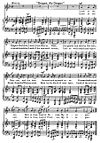
|
|
| Statehood pageant | Champoeg Historical Pageant | Each summer, the Champoeg Historical Pageant takes place at Champoeg State Park, where the first Oregon government was formed. The Oregon Parks and Recreation Department encourages the development of the pageant and promotes increased attendance at its performances. | 1987 | 
|
|
| Team | Portland Trail Blazers of 1990–1991 | The Trail Blazers of 1990–1991 were designated as the official team of Oregon for their success in setting a franchise record of 63 victories, including a 16-game winning streak. | 1991 | 
|
Unofficial symbols and unsuccessful proposals
While most states have an official nickname, the Oregon Legislature never officially adopted one. Oregon's unofficial nickname is "The Beaver State". Unofficial slogans for Oregon include "things look different here" and "Oregon, We Love Dreamers", the latter of which alludes to the "basic sense of idealism" of the state's culture. In the 1950s and 60s, Oregon license plates featured the unofficial motto, "Pacific Wonderland".
Several symbols have been proposed for addition to the list of official state symbols but were never adopted. The "Oregon Waltz" was approved as the state waltz by the Oregon House in 1997, but the proposal did not succeed in the Senate. In 2001, legislation designating the Kiger Mustang, a horse breed unique to southeastern Oregon, as the state horse was introduced, but not adopted. It was suggested in 2003 that Oregon have an official state tartan, but the bill never passed out of committee.
See also
References
- General
- "State Symbols". Oregon Blue Book. Oregon Secretary of State. Archived from the original on October 24, 2018. Retrieved October 25, 2009.
- "State Symbols: A to Z". Oregon Secretary of State. 2020. Archived from the original on November 29, 2020. Retrieved September 14, 2020.
- Specific
- ^ "Chapter 186 — State Emblems; State Boundary". Oregon Revised Statutes. 2011. Archived from the original on March 11, 2007. Retrieved May 30, 2013.
- ^ Gaston, Christian (May 23, 2013). "Oregon is first in nation with official state microbe: brewer's yeast". The Oregonian. Archived from the original on October 19, 2017. Retrieved May 30, 2013.
- "New York State Animal – Beaver". New York State Library. July 3, 2009. Archived from the original on November 9, 2008. Retrieved October 31, 2009.
- Rundquist, Tim (2000). How Heavy is the Mountain: An Alaskan Tour Manual/Novel. Writers Club Press. p. 492. ISBN 978-0-595-13120-4. Retrieved October 31, 2009.
- ^ "Oregon Almanac: Dance to Hot Springs". Oregon Blue Book. Oregon Secretary of State. Archived from the original on March 16, 2022. Retrieved October 28, 2009.
- ^ "Is there no end to this?". The Register-Guard. Guard Publishing. April 7, 1997. Retrieved November 1, 2009.
- "Oregon State Motto Timeline". Oregon State Legislature. Archived from the original on August 10, 2007. Retrieved November 23, 2006.
- Corning, Howard (1989). Dictionary of Oregon History. Binfords & Mort Publishing. p. 233.
- ^ "State Symbols: Mushroom to Tree". Oregon Blue Book. Oregon Secretary of State. Archived from the original on October 24, 2018. Retrieved October 25, 2009.
- ^ "Oregon Facts for School Reports – More Symbols". State of Oregon. Archived from the original on May 27, 2010. Retrieved October 27, 2009.
- "Oregon State University Official Athletic Site". CBS Interactive. Archived from the original on July 7, 2011. Retrieved October 27, 2009.
- "Learning Resources – State Symbols: Animal". Oregon Blue Book. Oregon Secretary of State. Archived from the original on October 25, 2018. Retrieved October 27, 2009.
- "House Joint Resolution 37, 2009 (Enrolled)". Oregon State Legislature. 2009. Archived from the original on June 11, 2011. Retrieved October 23, 2009.
- "Learning Resources – State Symbols: Fish". Oregon Blue Book. Oregon Secretary of State. Archived from the original on March 16, 2022. Retrieved October 27, 2009.
- Pojar, Jim; MacKinnon, Andy, eds. (1994). Plants of Coastal British Columbia: Including Washington, Oregon & Alaska, rev. ed. Vancouver: Lone Pine Publishing. p. 95. ISBN 978-1-55105-532-9.
- "Learning Resources – State Symbols: Flower". Oregon Blue Book. Oregon Secretary of State. Archived from the original on March 16, 2022. Retrieved October 25, 2009.
- "Oregon's Pear Industry". State of Oregon. Archived from the original on December 6, 2007. Retrieved October 25, 2009.
- "Oregon Facts for School Reports – More Symbols". State of Oregon. Archived from the original on May 27, 2010. Retrieved October 31, 2008.
- "House Concurrent Resolution 12, 2013". Oregon State Legislature. 2013. Retrieved May 30, 2013.
- Springhetti, Jim (October 18, 2008). "Chanterelles pop up, the perfect quarry". The Oregonian. Advance Publications.
- "Oregon's Hazelnut Industry". State of Oregon. Archived from the original on February 21, 2008. Retrieved October 25, 2009.
- "Oregon Almanac: Abbreviation to Crustacean". Oregon Blue Book. Oregon Secretary of State. Archived from the original on October 25, 2018. Retrieved December 21, 2021.
- Bragg, John (2009). "Hairy Oregon Shell Comes from a Famous Family" (PDF). South Slough News. State of Oregon. p. 1. Archived from the original (PDF) on June 16, 2009. Retrieved November 12, 2009.
- "Oregon Facts and Symbols". Oregon State Legislature. Archived from the original on June 17, 2008. Retrieved October 11, 2011.
- "SCR18 2017 Regular Session Testimony". Oregon State Legislature. Archived from the original on November 22, 2022. Retrieved November 22, 2022.
- "Western Meadowlark". Oregon Encyclopedia. Oregon Historical Society. Retrieved May 10, 2021.
- Oregonian/OregonLive, Julie Evensen | The (2024-09-25). "It's official. Oregon has a state vegetable". oregonlive. Retrieved 2024-11-10.
- ^ "State Symbols: Flag to Motto". Oregon Blue Book. Oregon Secretary of State. Archived from the original on March 16, 2022. Retrieved October 28, 2009.
- "Designates Metasequoia as official state fossil". Oregon State Legislature. 2005. Archived from the original on June 11, 2011. Retrieved October 31, 2009.
- "Oregon Almanac". Oregon Blue Book. Oregon Secretary of State. Archived from the original on June 29, 2018. Retrieved September 19, 2007.
- Christie, Tim (March 26, 2007). "Rock hounds check out goods at 18th annual Gem Faire". The Register-Guard. Guard Publishing.
- Mapes, Jeff (May 24, 2011). "Jory soil, not just any dirt, is named Oregon's state soil". The Oregonian.
- "House Concurrent Resolution 3, 2011". Oregon State Legislature. 2011. Archived from the original on August 5, 2012. Retrieved May 24, 2011.
- "State Symbols: Animal to Fish". Oregon Blue Book. Oregon Secretary of State. Archived from the original on October 24, 2018. Retrieved October 31, 2009.
- ^ "Oregon Legislature Kids Page". Oregon State Legislature. Archived from the original on September 23, 2006. Retrieved December 8, 2006.
- "Learning Resources – People to Know: John McLoughlin". Oregon Blue Book. Oregon Secretary of State. Archived from the original on October 24, 2018. Retrieved October 28, 2009.
- "Miss Oregon Pageant starts today in Seaside". The Oregonian. Advance Publications. July 8, 2004. p. B05. Archived from the original on April 23, 2018. Retrieved April 22, 2018.
- "The Miss Oregon Scholarship Program: Interesting Facts". The Miss Oregon Scholarship Program. Archived from the original on March 6, 2011. Retrieved October 31, 2009.
- Hastings, Terry; Joe Montalbano (1980). Hillsboro: My Home Town. Hillsboro Elementary School District 7.
- "Sheet Music Cover, Oregon, My Oregon". Oregon History Project. Archived from the original on February 19, 2022. Retrieved June 17, 2016.
- "Oregon Almanac:State Song". Oregon State Archives. Archived from the original on October 24, 2018. Retrieved September 10, 2007.
- "State lawmakers recognize Trail Blazers' 63–19 mark". The Register-Guard. Guard Publishing. June 19, 1991. Retrieved October 31, 2009.
- "Political Years Bring Back State Nicknames". Lodi News-Sentinel. Lodi, California. June 17, 1968. p. 9. Retrieved January 29, 2011.
- Mapes, Jeff (December 1, 2003). "State's new ad slogan highlights idealism". Portland Oregonian. Archived from the original on April 18, 2007. Retrieved January 27, 2011.
- "Pacific Wonderland License Plate". Retrieved 2020-10-25.
- Steves, David (January 23, 2001). "Senator trots out horse nominee". The Register-Guard. Guard Publishing. Retrieved November 1, 2009.
- "Senate Joint Resolution 31". Oregon Revised Statutes. 2003. Archived from the original on June 11, 2011. Retrieved November 6, 2009.
External links
- Tucker, Kathy. "Oregon state symbols". The Oregon Encyclopedia.
| U.S. state symbols by state | |
|---|---|
| |
| Territories and the federal district | |
| U.S. state symbols by type | |
|---|---|
|
Categories: